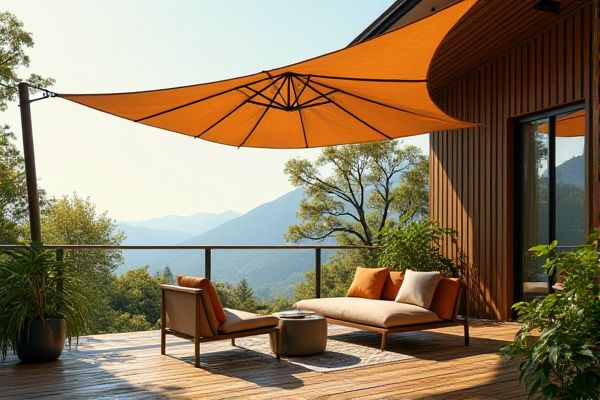
Sunshade sails offer broader coverage and a modern aesthetic, ideal for large outdoor spaces, while umbrellas provide targeted shade with easy portability and quick setup. Explore the rest of this article to discover which option best suits your outdoor shading needs.
Table of Comparison
| Feature | Sunshade Sail | Umbrella |
|---|---|---|
| Shade Coverage | Large, customizable area | Smaller, fixed area |
| Installation | Permanent or semi-permanent, requires mounting points | Portable, easy setup |
| Durability | High, weather-resistant fabric | Moderate, can be affected by wind |
| Wind Resistance | Better, tensioned design | Lower, prone to tipping or damage |
| UV Protection | Excellent, blocks up to 98% UV rays | Good, varies by material |
| Cost | Higher initial investment | Lower cost, affordable options |
| Mobility | Fixed location | Highly portable |
| Design Flexibility | Multiple shapes and colors | Limited designs |
Introduction to Sunshade Sails and Umbrellas
Sunshade sails and umbrellas both provide effective outdoor shade, with sunshade sails made from durable, UV-resistant fabric stretched tight between anchor points to cover larger areas. Umbrellas offer portable, adjustable coverage with a central pole, ideal for small spaces or movable shade. Your choice depends on the desired coverage area, installation permanence, and aesthetic preference for your outdoor space.
Design and Aesthetic Comparison
Sunshade sails offer a sleek, modern design with clean lines and a variety of shapes, colors, and sizes to create a customized outdoor space. Umbrellas provide a classic, versatile look with easily adjustable angles and straightforward installation, but they often require more maintenance. Your choice depends on the desired aesthetic impact and the architectural style of your outdoor area.
Installation and Setup Differences
Sunshade sails require tensioning between multiple fixed points using hardware such as turnbuckles and wall anchors, making installation more complex and time-consuming compared to umbrellas. Umbrellas typically feature a centralized pole with a straightforward base setup, allowing for quick and easy deployment without permanent fixtures. Sunshade sails offer customizable shapes and coverage areas, but umbrellas provide greater portability and simpler adjustment for changing sun angles.
Coverage Area and Flexibility
Sunshade sails provide a larger coverage area than umbrellas, making them ideal for shading wide outdoor spaces like patios and pools. Their flexible installation options allow you to adjust angles and tension for optimal sun protection, whereas umbrellas typically have fixed positions and smaller shaded zones. Choosing a sunshade sail enhances your outdoor comfort with expansive, customizable shade tailored to your space.
Durability and Weather Resistance
Sunshade sails are crafted from high-density polyethylene fabric that resists UV rays, mold, and mildew, offering superior durability and weather resistance compared to traditional umbrellas. Unlike umbrellas, sunshade sails maintain structural integrity in strong winds and prolonged sun exposure without fading or tearing. Umbrellas often feature metal or plastic frames prone to rust or damage in harsh weather, making sunshade sails a longer-lasting option for outdoor shade solutions.
Maintenance Requirements
Sunshade sails require periodic checks for fabric integrity and tension adjustments to prevent sagging and damage from wind exposure. Umbrellas often need regular cleaning and mechanical inspections to ensure smooth opening and closing operations, with potential replacements of ribs or canopies over time. Both options demand specific upkeep strategies to maximize longevity and functionality in outdoor environments.
Cost and Value Analysis
Sunshade sails generally offer a more cost-effective solution for covering large outdoor areas compared to umbrellas, with prices ranging from $50 to $600 depending on size and material quality. Umbrellas tend to be more expensive per square foot of coverage, priced between $100 and $1,000, and often require a sturdier base or installation. Sunshade sails provide greater value for durable, wind-resistant shade that can be customized to various shapes and sizes, making them ideal for budget-conscious outdoor shading.
Portability and Storage
Sunshade sails are lightweight and foldable, making them highly portable and easy to pack away in compact storage bags. Umbrellas often have bulkier frames and heavier materials, which can limit their portability and require more storage space. For those seeking convenience and minimal storage footprint, sunshade sails offer a superior solution compared to traditional umbrellas.
Best Use Cases for Each Option
Sunshade sails excel in covering large areas such as patios, playgrounds, and pools, providing extensive UV protection with a contemporary, minimalist aesthetic. Umbrellas are ideal for smaller, more flexible spaces like balcony corners or outdoor dining tables, offering easy mobility and adjustable shading. You should choose sunshade sails for permanent, broad coverage and umbrellas for versatile, on-demand shade solutions.
Conclusion: Choosing the Right Shade Solution
Sunshade sails offer a modern, customizable solution with larger coverage and stronger wind resistance compared to traditional umbrellas. Your choice depends on space, design preference, and durability needs, with sails excelling in open areas and umbrellas suited for portability and ease of use. Evaluate your outdoor environment and usage to select the optimal shade solution that enhances comfort and protection effectively.
 homyna.com
homyna.com